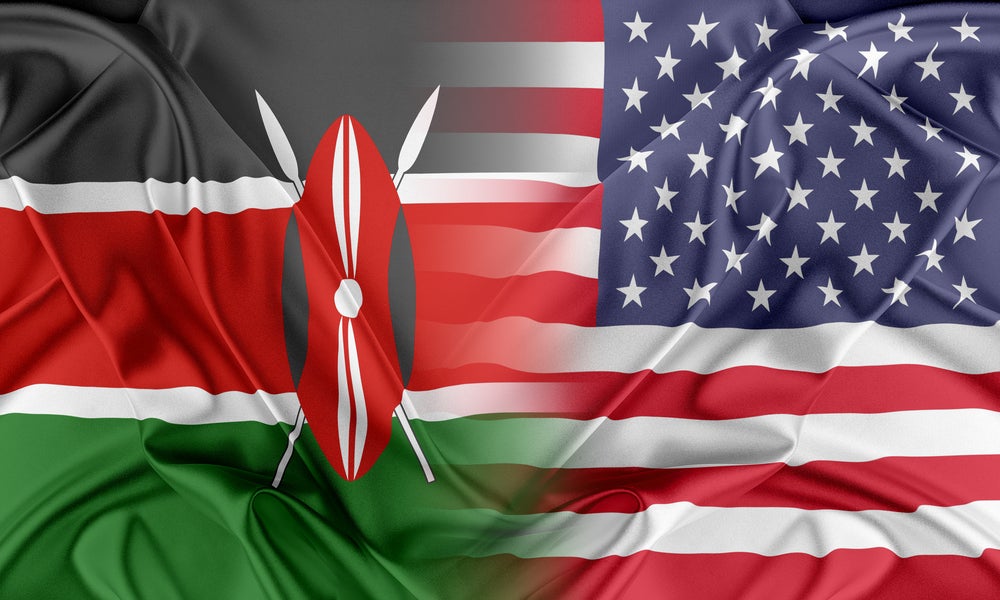
With retailers having stocked up early in anticipation of a busy holiday season, a month-on-month decline in US apparel import volumes in November was perhaps to be expected. Year-on-year, however, imports were up – with Cambodia recording the largest increase.
The latest figures from the Department of Commerce’s Office of Textiles and Apparel (OTEXA) show the volume of US apparel imports from all sources was down 16.4% month-on-month in November to 2.09bn square metre equivalents (SME). The figures, however, show a 2.1% increase against November last year, and a 5.6% increase in value to $6.31bn.
In terms of individual supplier countries, six of the top-ten recorded a year-on-year increase, with Cambodia booking the largest growth.
China – the largest supplier of apparel to the US – saw shipments climb 4% year-on-year to 855.4m SME. But imports from the country were down month-on-month from the 1.11m SME recorded in September. The second-largest supplier, Vietnam, booked year-on-year growth of 6% to 271m SME – an improvement on October’s increase of 0.8%.
Bangladesh, ranked number three in the top-ten league table, saw its exports to the US rise 6.9% year-on-year in November to 142.4m SME. Cambodia saw shipments increase 13.8% year-on-year to 69.4m SME, while El Salvador’s increased 9.6% to 71.1m SME.
See Also:
Of the remaining top-ten supplier countries, Nicaragua and Indonesia reported the largest year-on-year declines of 11% to 43.5m SME and 84m SME, respectively. India, meanwhile, recorded a fall of 3.6% to 74.4m SME and Honduras a decline of 2.4% to 95.3m SME. Mexico saw shipments edge up 1.1% year-on-year to 70.5m SME.
How well do you really know your competitors?
Access the most comprehensive Company Profiles on the market, powered by GlobalData. Save hours of research. Gain competitive edge.

Thank you!
Your download email will arrive shortly
Not ready to buy yet? Download a free sample
We are confident about the unique quality of our Company Profiles. However, we want you to make the most beneficial decision for your business, so we offer a free sample that you can download by submitting the below form
By GlobalDataApparel volumes – 12-month overview
| November | December | January | February | March | April | May | June | July | August | September | October | November | |
| China | 822 | 808 | 1068 | 785 | 544 | 731 | 824 | 950 | 1140 | 1299 | 1276 | 1115 | 855 |
| Vietnam | 256 | 261 | 348 | 279 | 271 | 288 | 297 | 296 | 335 | 327 | 295 | 333 | 271 |
| Bangladesh | 133 | 139 | 177 | 167 | 169 | 136 | 151 | 165 | 166 | 154 | 153 | 142 | 142 |
| Indonesia | 95 | 89 | 120 | 113 | 116 | 108 | 100 | 98 | 104 | 98 | 96 | 113 | 83 |
| Honduras | 98 | 90 | 58 | 85 | 99 | 83 | 96 | 93 | 93 | 99 | 87 | 79 | 95 |
| India | 77 | 73 | 94 | 96 | 112 | 96 | 96 | 88 | 94 | 84 | 77 | 93 | 74 |
| Cambodia | 61 | 57 | 81 | 75 | 77 | 69 | 57 | 59 | 85 | 89 | 107 | 91 | 69 |
| Mexico | 70 | 60 | 62 | 70 | 75 | 66 | 76 | 78 | 73 | 71 | 67 | 72 | 70 |
| El Salvador | 65 | 65 | 49 | 62 | 76 | 57 | 69 | 63 | 72 | 72 | 60 | 64 | 71 |
| Pakistan | 44 | 42 | 48 | null | null | null | null | null | null | null | null | null | null |
Source: The Department of Commerce’s Office of Textiles and Apparel (OTEXA)
Year-to-date and six-year overview
While monthly trade data is often volatile, with big swings from one month to the next, a broader view of the year shows the volume of total US apparel and textile imports was up 3.2% in the January to November period to 59.9bn SME, from 58.05bn SME in the same period last year. Within this, textiles grew 4.7% to 34.7bn SME, while apparel shipments edged up 1.1% to 25.2bn SME.
In value terms, total US apparel and textile imports edged up 1.2% to $98.38bn in the year-to-date, from $97.17bn in the same period a year ago. Apparel imports dropped 0.3% to $74.72bn, while textiles were up 6.4% to $23.65bn.
Six of the top ten apparel supplier countries booked growth during the first 11 months of the year, with Vietnam seeing the largest increase at 8.1% to 3.34bn SME.
India booked the second-highest gain, at 3.3% to 1bn SME. Imports from China, meanwhile, were up 2.1% to 10.57bn SME – with the country remaining by far the biggest supplier of apparel to the US with a 41.5% share of the market. Bangladesh, the third-largest supplier with a share of 6.9%, saw shipments edge up 0.1% compared with last year to 1.72bn SME.
Cambodia meanwhile, reported a 1.6% drop year-on-year to 859m SME – a decline on last month’s 1.83bn SME. El Salvador booked the largest decline, of 5.6% to 716 SME.
Taking a broader look at the data over a six-year period from 2010 to 2016, Vietnam is the only country in the top ten to have seen a steady increase in import volumes to the US, growing from 1.91bn SME in 2010 to 3.35bn SME in 2016 – increasing its share of total imports from 7.72% to 12.45%.
China’s imports have fluctuated over this period, from 10.4bn SME in 2010, falling to 9.74bn SME a year later, before reaching a peak of 11.38bn SME in 2015. Shipments declined in 2016 to 11.17bn SME. The country has lost marginal market share, from 41.98% in 2010 to 41.50% last year.
Cambodia, Mexico and Pakistan, meanwhile, are all exporting less to the US than they were six years ago. Cambodia fell from 947.1m SME to 903m SME in 2016, decreasing its share of the total from 3.83% in 2010 to 3.35% last year.
Apparel volumes – 5-year overview
| 2010 | 2011 | 2012 | 2013 | 2014 | 2015 | |
| China | 10387.05 | 9738.17 | 9881.9 | 10369.87 | 10780.06 | 11385.74 |
| Vietnam | 1910.504 | 1998.379 | 2145.041 | 2430.355 | 2751.083 | 3135.555 |
| Bangladesh | 1606.074 | 1539.527 | 1521.916 | 1692.447 | 1609.705 | 1869.943 |
| Indonesia | 1261.823 | 1307.397 | 1262.663 | 1261.802 | 1246.391 | 1264.028 |
| Honduras | 1271.9 | 1182.791 | 1118.705 | 1073.322 | 1084.782 | 1114.37 |
| India | 971.113 | 899.513 | 834.972 | 885.229 | 956.697 | 1023.545 |
| Cambodia | 947.108 | 1037.366 | 1039.162 | 1065.049 | 1020.708 | 1051.484 |
| Mexico | 952.327 | 946.174 | 897.016 | 908.5 | 916.85 | 898.399 |
| El Salvador | 819.839 | 782.192 | 789.751 | 796.812 | 788.692 | 813.004 |
| Pakistan | 697.933 | 625.846 | 581.654 | 584.016 | 586.273 | 590.969 |
Source: The Department of Commerce’s Office of Textiles and Apparel (OTEXA)
Facts behind the figures
While there continue to be concerns that increasing wages are undermining the competitiveness of China’s garment production on the world stage, the latest figures continue to confirm its appeal to apparel buyers as rising prices are largely being offset by productivity gains. No other country can match China in terms of the size of its supply base, its range of skills, its quality levels, its product variety and the completeness of its supply chain. The country also continues to lead the way when it comes to efficiency and infrastructure.
The latest figures show accumulated industrial profits in China’s apparel and textile sectors climbed in the first ten months of the year, up 8.6% and 3.2%, respectively.
Work has also been underway by China’s government to crack down on pollution, with tens of thousands of factories, including garment and textile facilities, shut down already. The national effort follows several months of investigations by the country’s Environment Bureau to determine which factories are not following environmental laws. The investigation has resulted in the closing of an estimated 40% of all China’s factories in order to lower air pollution levels.
Factories may also feel further pressure to conform following the launch last week of an online supply chain map of China linking brands and retailers to their suppliers’ environmental performance. The database and map provide real-time data and historical trends in air pollution emissions and wastewater discharge for nearly 15,000 major industrial facilities in China and access to environmental supervision records for over half a million more.
Last month, the country’s efforts to secure market economy status were dealt another blow after the US rejected its request to be treated as such under global trading rules. The US, Europe and others say their promise to grant China that status was contingent on it implementing market liberalisation measures that have yet to be carried out.
China apparel and textile profits climb in 10 months
Green supply chain map links China factories to brands
China bid for market economy status rejected by US
Meanwhile, Vietnam has benefited as producers and buyers diversify their supply chains, helped by its low labour costs and its industry focus on specialisation, modernisation, and increasing value added. Last month, the country made it onto the list of the world’s top ten textile exporters for the first time.
Manufacturers in Vietnam stand to gain from improved access to the EU import market once the EU-Vietnam free trade agreement comes into force, as well as increased foreign direct investment that flowed into the country’s textile and clothing sector ahead of the now-abandoned Trans-Pacific Partnership (TPP) trade agreement.
Vietnam’s textile and garment industry surpassed its 2017 target of US$30bn with an export turnover of over $31bn for the 12 month period, an increase of 10.2% on the prior year. The industry is now targeting exports of $34bn in 2018 as it looks to invest more in technology to increase productivity and shorten delivery times, and increase its focus on markets such as Australia and Russia.
In August, Vietnam’s National Wage Council proposed the minimum wage for 2018 will rise 6.5% to between VND2.76m and VND3.98m ($121-175) per month.
The government recently said it wants to elevate the country’s clothing manufacturing sector from its current low-cost model to an added value sector that includes design and branding. This is intended to help offset competition from neighbouring Cambodia and Myanmar, China, India, Bangladesh and Sri Lanka. While the Vietnam Textile and Apparel Association (VITAS), has urged garment and textile firms to apply new technologies to help increase productivity and use less labour.







